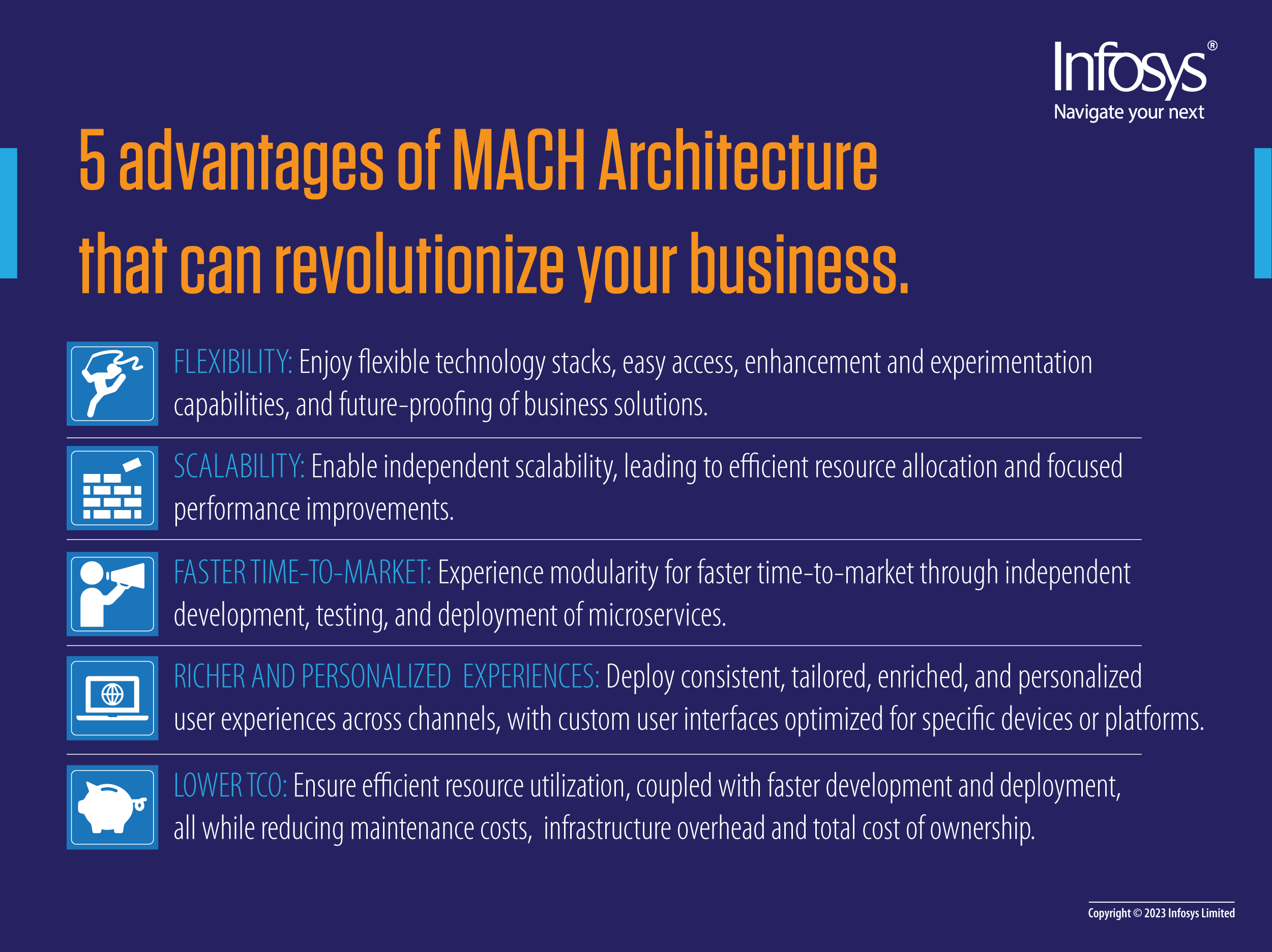In today’s digital landscape, businesses must respond quickly to new opportunities, market demands, and customer requirements. None of this is feasible without software systems that are modular, easy to modify, and can integrate with a wide range of technologies and platforms.
The MACH architecture provides the perfect solution by offering much needed flexibility by separating disparate business functions into independent functional services. According to the Infosys Digital Commerce Radar 2023 report, MACH can cope with the continuously evolving technology and customer needs. As a result, businesses can develop software solutions that can be easily extended without the risk of destabilizing the entire system. Moreover, MACH allows for creating specialized services that can dynamically connect, enabling businesses to scale their systems. Blogs 1 and 2 dealt with an overview of the architecture and its primary advantages.
Enterprises may find MACH architecture promising, but hurdles still exist. As discussed in our earlier blog, implementing a MACH architecture demands considerable time, resources and expertise depending on the business needs. It’s certainly not about adopting it because it is a flexible and evolved architecture system with a surplus of benefits. Yes, headless and composable architecture sounds exciting, but does your organization need it?
In essence, enterprises should consider several technical and business implications before adopting MACH architecture.
Here are three questions that enterprises must find answers to help make the critical decision. Answering these questions should clearly indicate the path ahead with MACH.
1. Does your business require a shift to composable architecture?
First, enterprises must be confident about the triggers for a move to MACH architecture. Remember that while MACH architecture is well-suited for distributed computing and promises business agility, innovation and flexibility, it leads to a much more complex landscape as it integrates with diverse solution components. For example, MACH architecture may be overkill if an organization develops a software system that entails less flexibility or scalability in business capabilities. In this case, MACH architecture may instead unnecessarily increase development complexity and costs, and the organization must assess the RoI of MACH architecture to get an accurate picture. The company may be better placed to stick with traditional architecture. It’s a tradeoff between getting the best-of-breed components versus investing significant resources and money.
2. Will the shift to MACH align with the business vision?
Enterprises must assess if the aspired technology landscape with MACH will help them grow revenues. In addition, they must determine if the investment in MACH yields suitable RoI for their business. It’s a given that MACH will usher in more capabilities and flexibility to cater to specific business needs. But enterprises must check if their business context necessitates these superior, flexible capabilities and a high cost. It’s a matter of deciding to start on a clean slate and build a system in a highly composable manner or selecting packaged business capabilities that offer limited flexibility. Depending on its plans and prospects, the business may well decide that a monolith is adequate for its purpose. On the other hand, it could opt for a MACH solution if it anticipates more growth in the future, as MACH is a future-proof approach. It all depends on what the business situation warrants.
3. Can your IT team handle the complexities of a MACH architecture?
Developing and maintaining a MACH system requires a high degree of technical expertise. Suppose an organization lacks the expertise or resources to work with MACH architecture. In that case, the absence of technical governance to direct the strategic technical vision implies that MACH is not the right path for them. In addition, the issue gets more complicated for those without a significant internal IT team as MACH solutions imply dealing with multiple vendors, and there is no single point of contact like in monolithic systems. So, an enterprise must carefully assess its performance and satisfaction with its existing monolithic systems. Because moving away from the status quo comes at a cost that must make business sense and is worth pursuing. Plus, as many solutions come together in the case of MACH architecture, it requires an IT leader with a solid understanding of the technology vision and the ability to execute in complete alignment with the business vision. This means investment in technical governance to guide them in the proper direction. Clearly, those enterprises with a limited IT setup must deliberate before switching to MACH solutions that demand a more sophisticated and mature structure.
Conclusion: Weighing the Pros and Cons of MACH Architecture
In conclusion, the MACH architecture offers businesses critical flexibility, agility, and scalability, but it is not a one-size-fits-all solution. Enterprises must carefully evaluate their technical and business needs and weigh the benefits of adopting MACH against the costs and tradeoffs involved. By answering the three questions discussed here, enterprises can make an informed decision on whether to adopt the MACH architecture and chart a path that best aligns with their business goals and objectives.











